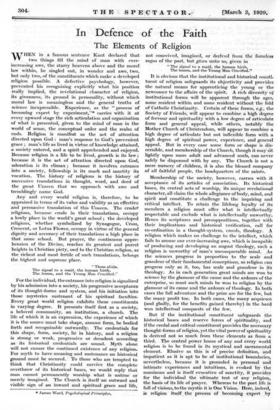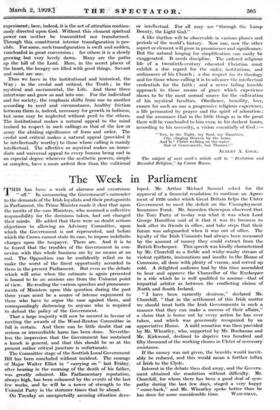In Defence of the Faith
The Elements of Religion
WHEN in a famous sentence Kant declared that - two things fill the mind of man with ever- increasing awe, the starry heavens above and the moral law within, he singled out, in wonder and awe, two, but only two, of the constituents which make a developed religion possible. A defective psychology, however, prevented his recognizing explicitly what his position really implied, the revelational character of religion, its givenness, its ground in personality, without which moral law is meaningless and the general truths of science inexpressible. Experience, as the " process of becoming expert by experiment,"* carries with it at every upward stage the rich articulation and organization of what is presented, given to the mind of man in the world of sense, the conceptual order and the realm of ends. Religion is manifest as the act of attention directed upon God : man's response to God's prevenient grace ; man's life as lived in virtue of knowledge attained, a society entered, and a spirit apprehended and enjoyed. Because religion is a life to be lived, growth is its law ; because it is the act of attention directed upon God, adoration is its climax ; because it involves entrance into a society, fellowship is its mark and sanctity its vocation. The history of religions is the history of successive translations in thought, word, and deed of the great Unseen that we approach with awe and tremblingly name God.
Any and every world religion is, therefore, to be appraised in terms of its value and validity as an effective and persuasive translation of this Unseen. The cruder religions, because ' crude in their translations, occupy a lowly place in the world's great school ; the developed religions, whether symbolized by Synagogue, Cross, Crescent, or Lotus Flower, occupy in virtue of the general dignity and accuracy of their translations a high place in that same school. But prayer, the continuous appre- hension of the Divine, reaches its greatest and purest heights in Christian piety, ksid to the Christian religion, as the richest and most fertile of such translations, belongs the highest and supreme place.
" These abide,
The signal to a maid, the hiiman birth, . The lesson, and the Young Man Crucified."
For the individual, the entrance into religion is signalized by his admission into a society, his progressive acceptance of its thought-forms and system, and his initiation into those mysteries siistenant of his spiritual faculties. Every great world religion exhibits these constituents in varying degree. It presents itself first as a society, a beloved community, an institution, a church. The life of which it is aid expression, the experience of which it is the source must take shape, assume form, be bodied forth and recognizable' outwardly. The credentials for this shape, form, society, lie in history, and a religion is strong or weak, progressive or decadent according as • its historical credentials are sound. Myth alone will not ensure the continued existence of any religion. For myth to have meaning and sustenance an historical ground must be secured. r To those who are tempted to think that Christianity could survive the complete overthrow of its historical bases, we would reply that man cannot permanently worship what is untrue or merely imagined. The Church is itself an Outward and visible sign of an inward and spiritual grace and life,
* James Ward, Psychological Principles,
not conceived, imagined, or derived from the formless sagas of the past, but given -unto us, given in • " The signal to a maid, the human birth, The lesson, and the Young Man Crucified."
It is obvious that the institutional and historical consti. tuent of religion safeguards its objectivity and provides the natural means for apprenticing the young or the newcomer to the affairs of the spirit. A rich diversity of institutional forms will be apparent through the ages, some resident within and some resident without the fold of Catholic Christianity. Certain of these forms, e.g.; the Society of Friends, will appear to combine a high degree of fervour and spirituality with a low degree of articulate form and general appeal, while others, notably the Mother Church of Christendom, will appear to combine a high degree of articulate but not inflexible form with a high degree of spiritual power, experience, and general appeal. But in every case some form or shape is dis- cernible, and membership of the Church, though it may sit lightly upon more adult and advanced souls, can never safely be dispensed with by any. The Church is not a mere nursery of children, it is also the blessed company of all faithful people, the- headquarters of the saints.
Membership of the society, however, carries with it acceptance of its articles of association. Its historical bases, its central acts, of worship, its unique reyelational character, all claim the whole allegiance of body, mind, and spirit and constitute a challenge to the inquiring and critical intellect. To retain the lifelong loyalty of its members a religion must offer what is intellectually respectable and exclude what is intellectually unworthy. Hence its scriptures and presuppositions, together with their implications and historical verification, call for co-ordination in a thought-system, creeds, theology. religion which makes no challenge to the intellect, which fails to arouse our ever-increasing awe, which is incapable of producing and developing an august theology, such a religion is unworthy of man's unconquerable mind. As the sciences progress in proportion to the scale and grandeur of their fundamental conceptions, so religion can progress only as it, too, has scale and grandeur in its theology. As in each generation great minds are won to science by the glamour of the cause and the ardours of the enterprise, so must such minds be won to religion by the glamour of its cause and the ardours of theology. In both cases the full adventure and the prize are for the few, but the many profit too. In both cases, the many acquiesce (and gladly, for the benefits gained thereby) in the hard won intellectual conquests of the few.
But if the institutional constituent safeguards the historical bases and reserve forces of spirituality, and if the credal and critical constituent provides the necessary thought-forms of religion, yet the vital power of spirituality is derived not so much from these elements as from a third. The central power house of any and every world religion is to be found in its mystical and sacramental element. Elusive as this is of precise definition, and impatient as it is apt to be of institutional boundaries, nevertheless,, because it is grounded in personal. and intimate experiences and intuitions, is evoked by the numinous and is itself evocative of sanctity, it provides for the individual the ultimate test of any religion, the basis of its life of prayer. Whereas to the poet life is full of visions, to the mystic it is One Vision. Here, indeed, is religion itself • the process of becoming expert hy experiment; here, indeed, it is the act of attention continu- ously directed upon God. Without this element spiritual power can neither be transmitted nor transformed. Through this constituent interior transfiguration is pos- sible. For some, such transfiguration is swift and sudden, vouchsafed in great conversion ; for others it is a slowly growing but very lovely dawn. Many are the paths up the hill of the. Lord. Here, in the secret places of the heart, the hungry are filled with good things. Savant and saint are one.
Thus we have in the institutional and historical, the Way ; in the credal and critical, the Truth ; in the mystical and sacramental, the Life. And these three intertwine and grow as and into one. For the individual and for society, the emphasis shifts from one to another according to need and circumstance, healthy friction between them is, indeed, necessary for growth in holiness, but none may be neglected without peril to the others, The institutional makes a natural appeal to the mind trained to respect, in such callings as that of the law or army the abiding significance of form and order. The credal and critical makes a natural appeal (provided it be intellectually worthy) to those whose calling is mainly intellectual. The affective or mystical makes an imme- diate and universal appeal to every human being and in an especial degree wherever .the aesthetic powers, simple or complex, have a more ardent flow than the volitional or intellectual. For all may see "through the Lainp Beauty, the Light God."
A like rhythm will be observable in various phases and periods of the world's history. Now one, now the other Aspect or element will grow in prominence and significance. But the natural longing for simplification can easily be exaggerated. It needs discipline. The ordered religiouS life of a twentieth-century educated Christian must exhibit a due regard for the order, institutions, and ordinances of his Church ; a due respect for its theology and for those whose calling it is to advance the intellectual credentials for the faith ; and a never failing humble approach to these means of grace which experience shows to be the most normal source for the cultivation of his mystical faculties. Obedience, humility, love, ensure for such an one a progressive religious experience, a life permeated by prayer and the spirit of adoration ; and the assurance that in the little things as in the great there will be vouchsafed to him even in his darkest hours, according to his necessity, a vision essentially of God :"-- " Yea, in the Night, my Soul, my Daughter, Cry, clinging Heaven by the hems, And lo ! Christ walking on the water Not of Gennesareth, but Thames ! "
ALBERT A. COCK.
The subject of next week's article will be " Evolution and Revealed Religion," by Canon Raven.

























































 Previous page
Previous page